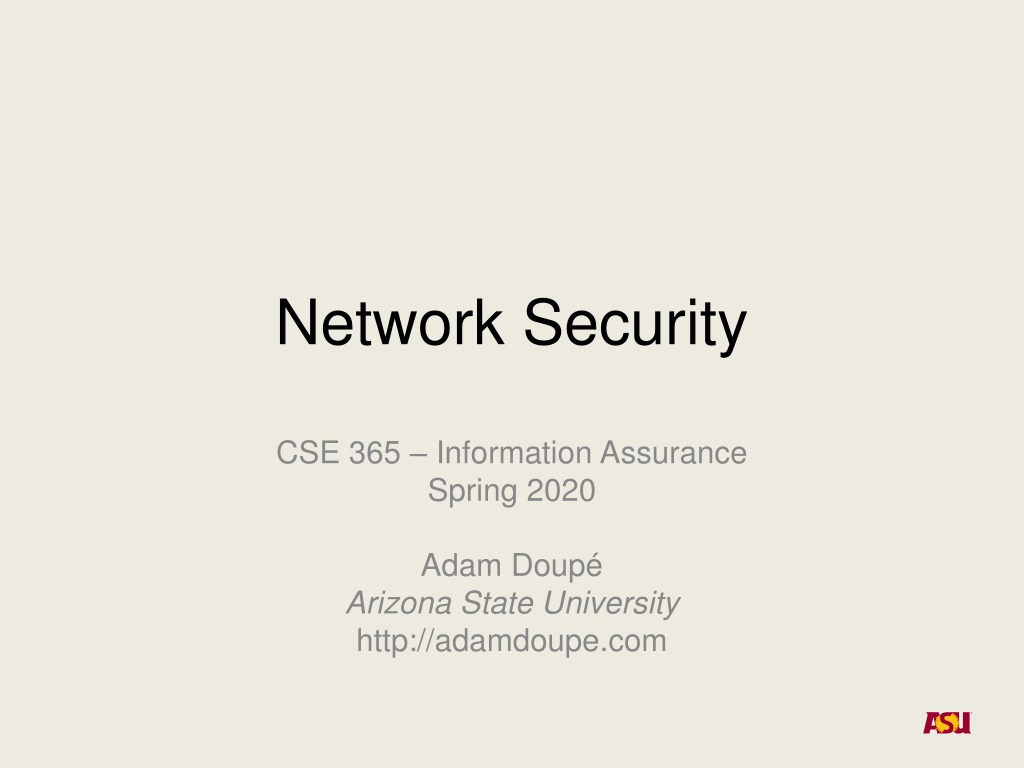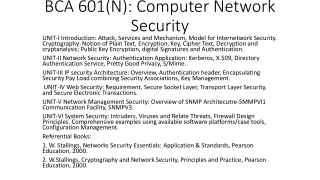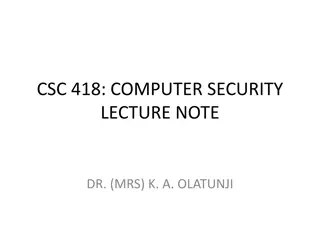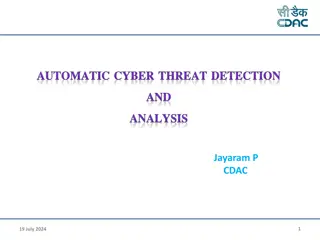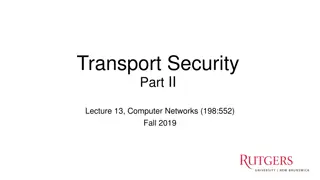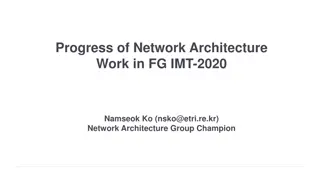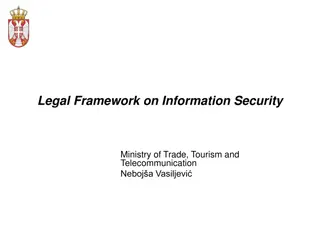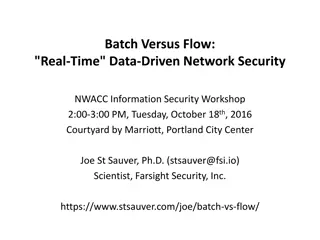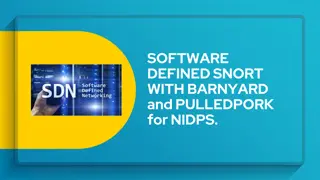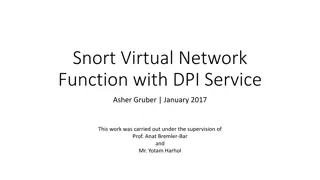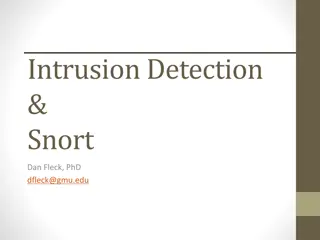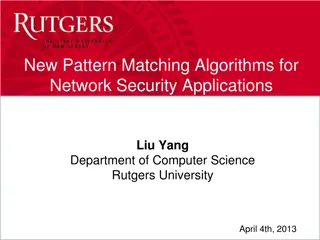Network Security
The content delves into various aspects of network security, IP protocols, TCP/IP layering, IP addressing, CIDR, Internet Protocol (IP), and IP datagrams. It covers topics such as the Internet Protocol Suite, TCP/IP layering, IP addresses, Classless Inter-Domain Routing (CIDR), and the Internet Protocol (IP) protocol. The information provided sheds light on the fundamentals of network security and key protocols used for data transmission between network nodes.
Download Presentation

Please find below an Image/Link to download the presentation.
The content on the website is provided AS IS for your information and personal use only. It may not be sold, licensed, or shared on other websites without obtaining consent from the author.If you encounter any issues during the download, it is possible that the publisher has removed the file from their server.
You are allowed to download the files provided on this website for personal or commercial use, subject to the condition that they are used lawfully. All files are the property of their respective owners.
The content on the website is provided AS IS for your information and personal use only. It may not be sold, licensed, or shared on other websites without obtaining consent from the author.
E N D
Presentation Transcript
Network Security CSE 365 Information Assurance Spring 2020 Adam Doup Arizona State University http://adamdoupe.com
The Internet Protocol Suite Set of protocols used to transport data between nodes of a network Also known as the TCP/IP Protocol Suite Based on abstraction and encapsulation Link protocols Internet protocols Transport protocols Application protocols Adam Doup , Information Assurance
TCP/IP Layering SMTP HTTP DNS NFS Application Transport TCP UDP IGMP IP ICMP Internet ARP RARP Hardware Interface Link Physical Layer
IP Addresses Each host has one or more IP addresses for each network interface IPv4 addresses are composed of 32 bits Represented in dotted-decimal notation: 149.169.175.207 Adam Doup , Information Assurance
Classless Inter-Domain Routing (CIDR) Allocation of large chunks of IP addresses wasted an enormous number of IP addresses Number of hosts is increasing IPv6 provides a larger address space but adoption is slow CIDR is an addressing scheme from 1993 for the Internet which allows for more efficient allocation of IP addresses The netid/hostid boundary can be placed on any bit between 13 and 27 32 hosts minimum 524,288 hosts maximum Adam Doup , Information Assurance
Internet Protocol (IP) The IP protocol represents the glue of the Internet The IP protocol provides a connectionless, unreliable, best-effort datagram delivery service (delivery, integrity, ordering, non-duplication, and bandwidth is not guaranteed) IP datagrams can be exchanged between any two nodes (provided they both have an IP address) For direct communication IP relies on a number of different lower-level protocols, e.g., Ethernet, Token Ring, FDDI, RS-232, 802.11 Adam Doup , Information Assurance
IP Datagram RFC 791 0 4 8 12 16 20 24 28 31 Version HL Service type (TOS) Identifier Protocol Total length Flags Fragment offset Time To Live Header checksum Source IP address Destination IP address Options Padding Data Adam Doup , Information Assurance
IP Datagram RFC 791 0 4 8 12 16 20 24 28 31 Version HL Service type (TOS) Identifier Protocol Total length Flags Fragment offset Time To Live Header checksum Source IP address Destination IP address Options Padding Data Adam Doup , Information Assurance
IP Encapsulation IP header IP data Frame header Frame data
IP: Direct Delivery If two hosts are in the same physical network the IP datagram is encapsulated in a lower level protocol and delivered directly Subnetwork111.10.20 111.10.20.121 From 111.10.20.121 To111.10.20.14 111.10.20.14 From 09:45:FA:07:22:23 To0A:12:33:B2:C4:11 09:45:FA:07:22:23 0A:12:33:B2:C4:11 Adam Doup , Information Assurance
Ethernet Frame dest (6) src (6) type (2) data (46-1500) CRC (4) 0x0800 IP datagram 0x0806 ARP (28) PAD (18) 0x0808 RARP (28) PAD (18)
Ethernet Widely-used link-layer protocol Uses CSMA/CD (Carrier Sense, Multiple Access with Collision Detection) Destination address: 48 bits (e.g., 09:45:FA:07:22:23) Source address: 48 bits Type: 2 bytes (IP, ARP, RARP) Data: Min 46 bytes (padding may be needed) Max 1500 bytes CRC: Cyclic Redundancy Check, 4 bytes Adam Doup , Information Assurance
Address Resolution Protocol The address resolution protocol (ARP) allows a host to map IP addresses to the link-level addresses associated with the peer s hardware interface (e.g., Ethernet) to be used in direct delivery ARP messages are encapsulated in the underlying link level protocol Adam Doup , Information Assurance
ARP Request hosta# arp -a hosta# ping 192.168.1.10 8:0:46:7:4:a3 ff:ff:ff:ff:ff:ff arp 60: arp who-has 192.168.1.10 tell 192.168.1.100 0:1:3:1d:98:b8 8:0:46:7:4:a3 arp 60: arp reply 192.168.1.10 is-at 0:1:3:1d:98:b8 8:0:46:7:4:a3 0:1:3:1d:98:b8 ip 98: 192.168.1.100 > 192.168.1.10: icmp: echo request 0:1:3:1d:98:b8 8:0:46:7:4:a3 ip 98: 192.168.1.10 > 192.168.1.100: icmp: echo reply hosta# arp -a hostb (192.168.1.10) at 00:01:03:1D:98:B8 [ether] on eth0 hostb# arp -a hosta (192.168.1.100) at 08:00:46:07:04:A3 [ether] on eth0 ARP request ARP reply Host B 192.168.1.10 0:1:3:1d:98:b8 Host A 192.168.1.100 08:00:46:07:04:A3 Host C
Local Area Network Attacks Goals Impersonation of a host Denial of service Access to information Tampering with delivery mechanisms Sniffing Spoofing Hijacking Adam Doup , Information Assurance
Hubs vs. Switches Early network switches were simple hubs All traffic is broadcasted to all ports Modern network switches keep track of which interface is connected to each port All broadcast traffic is sent to all connected hosts All directed traffic is sent to the ports associated with the referenced hardware address Adam Doup , Information Assurance
Network Sniffing Technique at the basis of many attacks The attacker sets his/her network interface in promiscuous mode If switched Ethernet is used, then the switch must be convinced that a copy of the traffic needs to be sent to the port of the sniffing host Adam Doup , Information Assurance
Why Sniffing? Many protocols (FTP, POP, HTTP, IMAP) transfer authentication information in the clear By sniffing the traffic it is possible to collect usernames/passwords, files, mail, etc. Usually traffic is copied to a file for later analysis Adam Doup , Information Assurance
Sniffing Tools Tools to collect, analyze, and reply traffic Routinely used for traffic analysis and troubleshooting Command-line tools tcpdump: collects traffic tcpflow: reassemblesTCP flows tcpreplay: re-sends recorded traffic Graphical tools Wireshark Supports TCP reassembling Provides parsers for a number of protocols Adam Doup , Information Assurance
ARP Spoofing Goal: sniff all traffic between two hosts in a switched environment The attack leverages the stateless nature of the ARP protocol Replies without a request will be accepted The attacker host sends spoofed ARP messages to the two victim hosts, poisoning their cache The victim host sends their IP packets to the attacker host The attacker host acts has a router Adam Doup , Information Assurance
ARP Spoofing Host A Host B 192.168.1.100 at 08:00:46:07:04:A3 192.168.1.10 at 00:01:03:1d:98:b8 Host C 192.168.1.100 08:00:46:07:04:A3 192.168.1.10 00:01:03:1D:98:B8 192.168.1.137 at BA:DB:AD:BA:DB:AD 192.168.1.100 08:00:46:07:04:A3 192.168.1.10 00:01:03:1D:98:B8
ARP Spoofing ARP Reply: 192.168.1.10 is at BA:DB:AD:BA:DB:AD Host A Host B 192.168.1.100 at 08:00:46:07:04:A3 192.168.1.10 at 00:01:03:1d:98:b8 Host C 192.168.1.100 08:00:46:07:04:A3 192.168.1.10 00:01:03:1D:98:B8 192.168.1.137 at BA:DB:AD:BA:DB:AD 192.168.1.100 08:00:46:07:04:A3 192.168.1.10 00:01:03:1D:98:B8
ARP Spoofing ARP Reply: 192.168.1.10 is at BA:DB:AD:BA:DB:AD Host A Host B 192.168.1.100 at 08:00:46:07:04:A3 192.168.1.10 at 00:01:03:1d:98:b8 Host C 192.168.1.100 08:00:46:07:04:A3 192.168.1.10 BA:DB:AD:BA:DB:AD 192.168.1.137 at BA:DB:AD:BA:DB:AD 192.168.1.100 08:00:46:07:04:A3 192.168.1.10 00:01:03:1D:98:B8
ARP Spoofing ARP Reply: 192.168.1.100 is at BA:DB:AD:BA:DB:AD Host A Host B 192.168.1.100 at 08:00:46:07:04:A3 192.168.1.10 at 00:01:03:1d:98:b8 Host C 192.168.1.100 08:00:46:07:04:A3 192.168.1.10 BA:DB:AD:BA:DB:AD 192.168.1.137 at BA:DB:AD:BA:DB:AD 192.168.1.100 08:00:46:07:04:A3 192.168.1.10 00:01:03:1D:98:B8
ARP Spoofing ARP Reply: 192.168.1.100 is at BA:DB:AD:BA:DB:AD Host A Host B 192.168.1.100 at 08:00:46:07:04:A3 192.168.1.10 at 00:01:03:1d:98:b8 Host C 192.168.1.100 BA:DB:AD:BA:DB:AD 192.168.1.10 BA:DB:AD:BA:DB:AD 192.168.1.137 at BA:DB:AD:BA:DB:AD 192.168.1.100 08:00:46:07:04:A3 192.168.1.10 00:01:03:1D:98:B8
ARP Spoofing Ethernet: BA:DB:AD:BA:DB:AD IP: 192.168.1.100 Data: SECRET Host A Host B 192.168.1.100 at 08:00:46:07:04:A3 192.168.1.10 at 00:01:03:1d:98:b8 Host C 192.168.1.100 BA:DB:AD:BA:DB:AD 192.168.1.10 BA:DB:AD:BA:DB:AD 192.168.1.137 at BA:DB:AD:BA:DB:AD 192.168.1.100 08:00:46:07:04:A3 192.168.1.10 00:01:03:1D:98:B8
ARP Spoofing Ethernet: 00:01:03:1D:98:B8 IP: 192.168.1.10 Data: SECRET Host A Host B 192.168.1.100 at 08:00:46:07:04:A3 192.168.1.10 at 00:01:03:1d:98:b8 Host C 192.168.1.100 BA:DB:AD:BA:DB:AD 192.168.1.10 BA:DB:AD:BA:DB:AD 192.168.1.137 at BA:DB:AD:BA:DB:AD 192.168.1.100 08:00:46:07:04:A3 192.168.1.10 00:01:03:1D:98:B8
ARP Spoofing Legitimate ARP replies might restore the ARP cache to the correct value Most ARP-spoofing tool repeatedly send spoofed ARP replies to keep the ARP cache in the desired state ettercap Adam Doup , Information Assurance
IP Spoofing In an IP spoofing attack a host impersonates another host by sending a datagram with the address of the impersonated host as the source address Subnetwork111.10.20 111.10.20.121 From 111.10.20.76 To111.10.20.14 111.10.20.14 111.10.20.76 From 09:45:FA:07:22:23 To0A:12:33:B2:C4:11 09:45:FA:07:22:23 0A:12:33:B2:C4:11 Adam Doup , Information Assurance
Routing: Indirect Delivery If two hosts are in different physical networks the IP datagram is encapsulated in a lower level protocol and delivered to the directly connected gateway The gateway decides which is the next step in the delivery process This step is repeated until a gateway that is in the same physical subnetwork of the destination host is reached Then direct delivery is used Adam Doup , Information Assurance
Routing From 111.10.20.121 To 128.111.41.10 Source/Destination IP addresses are the same for every copy of the datagram TTL field is decreased at every step Link level addresses change at every step The delivery process is based on the destination address only A0:B0:C0:D0:E0:F0 A1:B1:C1:D1:E1:F1 111.10.20.121 AA:BB:CC:DD:EE:FF 128.111.41.10 11:21:31:41:51:61 From AA:BB:CC:DD:EE:FF To A0:B0:C0:D0:E0:F0 From A1:B1:C1:D1:E1:F1 To 11:21:31:41:51:61
Types of Routing Hop-by-hop routing The delivery route is determined by the gateways that participate in the delivery process Source routing The originator of a datagram determines the route to follow independently before sending the datagram (IP source routing option) Adam Doup , Information Assurance
Hop-by-hop Routing: The Routing Table The information about delivery is maintained in the routing table $ route n Kernel IP routing table Destination Gateway Genmask Flags Iface 192.168.1.24 0.0.0.0 255.255.255.255 UH eth0 192.168.1.0 0.0.0.0 255.255.255.0 U eth0 127.0.0.0 0.0.0.0 255.0.0.0 U lo 0.0.0.0 192.168.1.1 0.0.0.0 UG eth0 Flags U: the route is up G: the destination is a gateway H: the route is to a host (if not set, the route is to a network) D: the route was created by a redirectmessage M: the route was modified by a redirect message Adam Doup , Information Assurance
Routing Mechanism Search for a matching host address Search for a matching network address Search for a default entry If a match is not found a message of host unreachable or network unreachable is returned (by the kernel or by a remote gateway by using ICMP) Routing tables can be set Statically (at startup, or by using the "route" or "ip route" command) Dynamically (using routing protocols) Adam Doup , Information Assurance
TCP/IP Layering SMTP HTTP DNS NFS Application Transport TCP UDP IGMP IP ICMP Internet ARP RARP Hardware Interface Link Physical Layer
User Datagram Protocol (UDP) The UDP protocol relies on IP to provide a connectionless, unreliable, best-effort datagram delivery service (delivery, integrity, non-duplication, ordering, and bandwidth is not guaranteed) Introduces the port abstraction that allows one to address different message destinations for the same IP address Often used for multimedia (more efficient than TCP) and for services based on request/reply schema (DNS, NFS, RPC) Adam Doup , Information Assurance
UDP Message 0 4 8 12 16 20 24 28 31 UDP source port UDP message length UDP destination port Checksum Data Adam Doup , Information Assurance
UDP Message 0 4 8 12 16 20 24 28 31 UDP source port UDP message length UDP destination port Checksum Data Adam Doup , Information Assurance
UDP Encapsulation UDP header UDP data IP header IP data Frame header Frame data Adam Doup , Information Assurance
UDP Spoofing Basically IP spoofing Spoofed UDP request UDP reply Trusted client Server Attacker Adam Doup , Information Assurance
UDP Hijacking Variation of the UDP spoofing attack UDP request Spoofed UDP reply UDP reply UDP request Client Server Attacker Adam Doup , Information Assurance
UDP Portscan Used to determine which UDP services are available A zero-length UDP packet is sent to each port If an ICMP error message "port unreachable" is received the service is assumed to be unavailable Many TCP/IP stack implementations implement a limit on the error message rate, therefore this type of scan can be slow (e.g., Linux limit is 80 messages every 4 seconds) Adam Doup , Information Assurance
UDP Portscan % nmap -sU 192.168.1.10 Starting nmap by fyodor@insecure.org ( www.insecure.org/nmap/ ) Interesting ports on (192.168.1.10): (The 1445 ports scanned but not shown below are in state: closed) Port State Service 137/udp open netbios-ns 138/udp open netbios-dgm Nmap run completed -- 1 IP address (1 host up) scanned in 4 seconds Adam Doup , Information Assurance
Transmission Control Protocol (TCP) The TCP protocol relies on IP to provide a connection- oriented, reliable stream delivery service (no loss, no duplication, no transmission errors, correct ordering) TCP, as UDP, provides the port abstraction TCP allows two nodes to establish a virtual circuit, identified by source IP address, destination IP address, source TCP port, destination TCP port The virtual circuit is composed of two streams (full- duplex connection) The couple IP address/port number is sometimes called a socket (and the two streams are called a socket pair) Adam Doup , Information Assurance
TCP Segment 0 4 8 12 16 20 24 28 31 Source port Destination port Sequence number Acknowledgment number Flags HLEN Reserved Window Urgent pointer Checksum Options Padding Data Adam Doup , Information Assurance
TCP Segment 0 4 8 12 16 20 24 28 31 Source port Destination port Sequence number Acknowledgment number Flags HLEN Reserved Window Urgent pointer Checksum Options Padding Data Adam Doup , Information Assurance
TCP Encapsulation TCP header TCP data IP header IP data Frame header Frame data
TCP Seq/Ack Numbers The sequence number specifies the position of the segment data in the communication stream (SYN=13423 means: the payload of this segment contains the data from byte 13423 to byte 13458) The acknowledgment number specifies the position of the next byte expected from the communication partner (ACK = 16754 means: I have received correctly up to byte 16753 in the stream, I expect the next byte to be 16754) These numbers are used to manage retransmission of lost segments, duplication, flow control Adam Doup , Information Assurance
TCP Flags Flags are used to manage the establishment and shutdown of a virtual circuit SYN: request for the synchronization of syn/ack numbers (used in connection setup) ACK: states the acknowledgment number is valid (all segment in a virtual circuit have this flag set, except for the first one) FIN: request to shutdown one stream RST: request to immediately reset the virtual circuit URG: states that the Urgent Pointer is valid PSH: request a push operation on the stream (that is, the stream data should be passed to the user application as soon as possible) Adam Doup , Information Assurance
TCP Virtual Circuit: Setup A server, listening to a specific port, receives a connection request from a client: The segment containing the request is marked with the SYN flag and contains a random initial sequence number Sc The server answers with a segment marked with both the SYN and ACK flags and containing an initial random sequence number Ss Sc + 1 as the acknowledgment number The client sends a segment with the ACK flag set and with sequence number Sc + 1 and acknowledgment number Ss + 1 Adam Doup , Information Assurance
